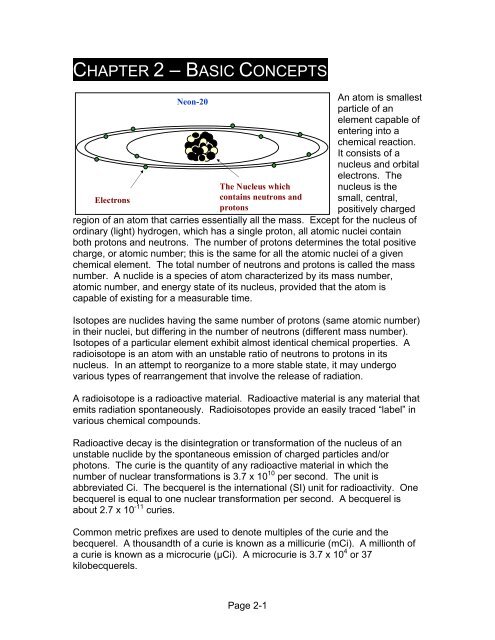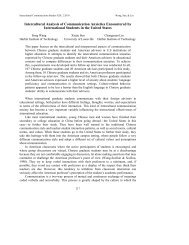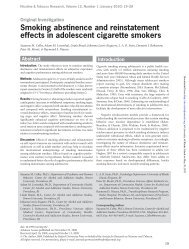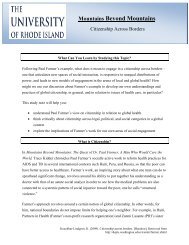You also want an ePaper? Increase the reach of your titles
YUMPU automatically turns print PDFs into web optimized ePapers that Google loves.
<strong>CHAPTER</strong> 2 <strong>–</strong> <strong>BASIC</strong> <strong>CONCEPTS</strong>ElectronsNeon-20The Nucleus whichcontains neutrons andprotonsAn atom is smallestparticle of anelement capable ofentering into achemical reaction.It consists of anucleus and orbitalelectrons. Thenucleus is thesmall, central,positively chargedregion of an atom that carries essentially all the mass. Except for the nucleus ofordinary (light) hydrogen, which has a single proton, all atomic nuclei containboth protons and neutrons. The number of protons determines the total positivecharge, or atomic number; this is the same for all the atomic nuclei of a givenchemical element. The total number of neutrons and protons is called the massnumber. A nuclide is a species of atom characterized by its mass number,atomic number, and energy state of its nucleus, provided that the atom iscapable of existing for a measurable time.Isotopes are nuclides having the same number of protons (same atomic number)in their nuclei, but differing in the number of neutrons (different mass number).Isotopes of a particular element exhibit almost identical chemical properties. Aradioisotope is an atom with an unstable ratio of neutrons to protons in itsnucleus. In an attempt to reorganize to a more stable state, it may undergovarious types of rearrangement that involve the release of radiation.A radioisotope is a radioactive material. Radioactive material is any material thatemits radiation spontaneously. Radioisotopes provide an easily traced “label” invarious chemical compounds.Radioactive decay is the disintegration or transformation of the nucleus of anunstable nuclide by the spontaneous emission of charged particles and/orphotons. The curie is the quantity of any radioactive material in which thenumber of nuclear transformations is 3.7 x 10 10 per second. The unit isabbreviated Ci. The becquerel is the international (SI) unit for radioactivity. Onebecquerel is equal to one nuclear transformation per second. A becquerel isabout 2.7 x 10 -11 curies.Common metric prefixes are used to denote multiples of the curie and thebecquerel. A thousandth of a curie is known as a millicurie (mCi). A millionth ofa curie is known as a microcurie (µCi). A microcurie is 3.7 x 10 4 or 37kilobecquerels.Page 2-1
Radioactive materials have an associated half-life, or decay time characteristic ofthat isotope. As radiation is emitted, the material becomes less radioactive overtime, decaying exponentially. Since it is impossible or impractical to measurehow long one atom takes to decay, the amount of time it takes for half of the totalamount of radioactive material to decay is used to calculate half-life. Someradioisotopes have long half-lives; for example, Carbon-14 takes 5,730 years forany given quantity to decay to half of the original amount of radioactivity. Otherradioactive materials have short half-lives; Phosphorus-32 has an approximatelytwo-week half-life, and Technetium-99m (used in human and animal nuclearmedicine diagnostic procedures) has a half-life of 6 hours.Half-life is important for many reasons. When deposited in the human body, thehalf-life of the radioactive material present in the body affects the amount of theexposure. Materials with shorter half-lives typically cause less dose for a givenactivity than materials with longer half-lives. If the radioactive materialcontaminates a workbench or equipment, and is not removable, the amount oftime before the contaminated items may be used again is determined by theradioactive half-life. Radioisotope decay (using shorter half-life isotopes) helps tominimize costs in radioactive waste management.The equation used to calculate radioactive decay is shown below.A = A 0 e -λtWhere:A = Current amount of radioactivityA 0 = Original amount of radioactivitye = base natural log (approximately 2.718)λ = decay constant = 0.693/t 1/2 (where t 1/2 = half-life)t = the amount of time elapsed from A 0 to ABe careful with the units used for the time. Days, hours and years must not bemixed in the calculation.Sample Calculation: You have a vial of solution containing Phosphorus-32 with aknown activity of 205 µCi on April 2. You want to know how much activityremains on April 28, i.e., 26 days later. The half-life of Phosphorus-32 is 14.3days.We’ll let A = the activity remaining on April 28. A 0 is the original activity, 205 µCi.T is the elapsed time, 26 days.First, we’ll calculate the decay constant λ.λ = 0.693 ÷14.3 days or 0.0485 days -1 .Page 2-2
Then, we can calculate the remaining activity.The remaining activity A equals 58 µCiA = A 0 e -λt-0.0485 x 26A = 205 eA = 205 x 0.283A labeled compound is a compound consisting, in part, of radioactively labeledmolecules. By observations of radioactivity or isotopic composition thecompound or its fragments may be followed through physical, chemical orbiological processes.For the purposes of thismanual, we will restrictour discussion to alphaand beta particles, and x-rays and gamma rays.An alpha particle is astrongly ionizing particleemitted from the nucleusduring radioactive decayhaving a mass andcharge equal inmagnitude to a heliumnucleus, consisting of 2protons and 2 neutronswith a double positive charge.DaughterNucleusCalcium-40Beta Particle RadiationParent NucleusPotassium-40Alpha Particle RadiationDaughterNucleusTh-231Parent NucleusU-2354 2 α ++0 0 νAntineutrinoAlpha Particle(Helium Nucleus)A beta particle is a chargedparticle emitted from thenucleus of an atom duringradioactive decay. Anegatively charged betaparticle is identical to anelectron. A positivelycharged beta particle iscalled a positron.0 −1 β − X-rays and gamma rays arepenetrating electromagneticBeta Particle radiation. Electromagneticradiation is a traveling wavemotion resulting from changing electric or magnetic fields. ElectromagneticPage 2-3
adiation ranges from x-rays (and gamma rays) of short wavelength, through theultraviolet, visible, and infrared regions, to radar and radio waves of relativelylong wavelength. All electromagnetic radiation travels in a vacuum with thevelocity of light.In 1895, Roentgen discovered x-rays. The key to Roentgen's discovery was adevice called a Crooke’s tube. A Cooke's tube is a glass envelope under highvacuum, with a wire element at one end forming the cathode, and a heavycopper target at the other end forming the anode. When a high voltage wasapplied to the electrodes, electrons formed at the cathode are pulled toward theanode and strike the copper with very high energy. Roentgen discovered thatvery penetrating radiation was produced from the anode, which he called x-rays.ElectronTarget NucleusTungstenDaughter NucleusNi-60X-RayWhenever electrons of highenergy strike a heavy metaltarget, like tungsten orcopper x-rays are produced.When electrons hit thismaterial, some of theelectrons will approach the nucleus of the metal atoms where they are deflectedbecause of their opposite charges (electrons are negative and the nucleus ispositive, so the electrons are attracted to the nucleus). This deflection causesthe energy of the electron to decrease, and this decrease in energy forms a x-ray.X-rays are produced by bombarding a metallic target with fast electrons in a highvacuum or in transitions of orbital electrons into lower energy states. In nuclearreactions it is customary to refer to photons originating in the nucleus as gammarays, and those originating outside the nucleus as x-rays. X-rays are sometimescalled Roentgen rays after their discoverer, W.C. Roentgen.Parent NucleusCobalt-600−1 β − A gamma ray is a verypenetrating electromagneticradiation of nuclear origin.Except for its origin, it isidentical to a x-ray.Gamma RaysAlpha and beta particles,and x-rays and gamma raysare ionizing radiation.Ionizing radiation has the ability to remove electrons from atoms creating ions.An ion is an atom that has too many or too few electrons, causing it to bechemically active. Ions may be positively or negatively charged, and vary in size.The typical result of ionizing radiation interactions is the production of negativelycharged free electrons and positively charged ionized atoms.Page 2-4
















